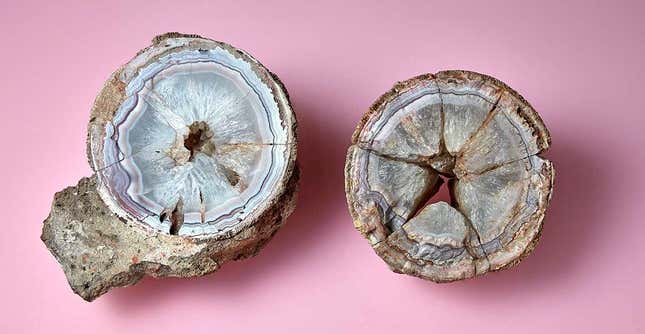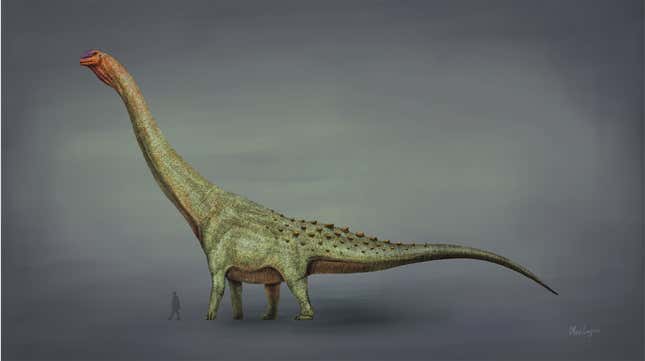
140 years ago, an agate specimen from India was registered in the Mineralogy Collection at London’s Natural History Museum. Now, a team of researchers say the suspiciously spherical agate formed inside a 60-million-year-old dinosaur egg.
The agatized egg likely belonged to a titanosaur, which were common in what is now India during the Cretaceous. (Earlier this year, nearly 100 titanosaur nests in India were comprehensively identified and documented.)
Robin Hansen, a mineral curator at the museum, brought the specimen to Paul Barrett and Susannah Maidment, both dinosaur experts at the museum. The group agreed that the agate was approximately the right shape and size to be a dinosaur egg and noted that external texture of the mineral was similar to the texture of an egg. Furthermore, the outer edges of the specimen suggested that other, similarly shaped objects were once abutting the 6-inch-wide agate—like a clutch of dinosaur eggs.
‘This specimen is a perfect example of why museum collections are so important,” Hansen said in an NHM release. “It was identified and cataloged correctly as an agate in 1883 using the scientific knowledge available at the time ... It is only now that we have recognized that this specimen has something extra special—the agate has infilled this spherical structure, which turns out to be a dinosaur egg.”

Fight hair loss with science
Right now, you can get The Hair Revitalizing Complex Full Set for the price of the Refill. That’s just $98 for a 30-day supply, and $32 off the supplement’s normal price. This supplement is proven to deliver results. Augustinus Bader performed a six-month double blind trial that found those on the supplement had increased their hair count by 56%, hair shine by 100%, and saw a 98% reduction in hair damage compared to those who took a placebo.

Despite being the largest land animals to ever live, titanosaurs laid eggs that weren’t particularly massive. That’s likely because the animals produced clutches of several dozen eggs, rather than a single (larger) offspring with each individual cycle. That’s not entirely surprising, as the latter is a habit among mammalian megafauna, while reptilian megafauna stick to the egg-clutch model of reproduction.
According to the museum release, it’s possible that the agatized egg formed due to volcanic activity in the region: Shortly after the eggs were laid, a volcanic eruption may have covered the clutch, and water rich with silicates may have leached into the preserved eggshells, forming the agate.
This remarkable fossil specimen is something of a deluxe version of ammolite mollusk shells, which become iridescent under specific fossilization circumstances.
More: Beautifully Preserved Dinosaur Embryo Spotted in Fossilized Egg